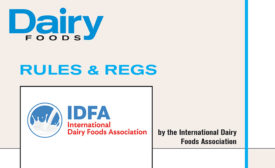Dairy Foods Columnists
A team of dairy industry food safety experts just finalized an in-depth, yet practical Listeria control guidance document for ice cream and other ready-to-eat dairy products.
Read More
Food for thought: use nutrient trading to improve water quality
Despite years of progress, more than half of the nation’s waterways still do not meet water quality standards.
April 13, 2016
7 philosophical approaches to handling product recalls
Dairy processors cannot hide their heads in the sand when it comes to food safety. Learn from the mistakes of other food manufacturers so that you can avoid a product recall.
April 12, 2016
In the case of eyes in cheese, size matters
Cheesemakers need to understand fermentation and gas development to avoid defects in their cheese or when they want to create the right number and size of eyes in certain cheeses.
April 7, 2016
Freeze ice cream from the inside out
Extremely cold ‘cryobits’ accelerate temperature reduction of the packaged product. Ice crystals and air bubbles are significantly smaller with partial cryogenic hardening compared to traditional hardening methods.
April 6, 2016
Dairy foods contribute to overall health at any age
Dairy foods and beverages are a core component of healthy eating plans for infants, children and seniors.
April 5, 2016
Does your dairy operation have a ‘culture of clean’?
A proper cleaning protocol consists of more than just 'pre-rinse, wash, post-rinse, sanitize.' Follow these step-by-step procedures to assure satisfactory results day after day.
March 14, 2016
Stay ahead of the curve. Unlock a dose of cutting-edge insights.
Receive our premium content directly to your inbox.
SIGN-UP TODAYCopyright ©2024. All Rights Reserved BNP Media.
Design, CMS, Hosting & Web Development :: ePublishing















